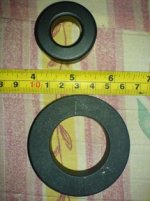Not a clue, but the first thing to do is figure out what they are. If you can measure inductance, wind some arbitrary number of turns on them, like 20, and measure the inductance. Then measure the dimensions with your ruler. Download this spreadsheet (untested!) to get the parameters. Then, peruse the catalogs and websites of the usual suspects to figure out what you've got- Micrometals, Amidon, etc. Once you know that, their catalog info will give you some idea of what power you can get out.
Playing Sherlock Holmes to actually figure out the brand and part number of your cores, may be akin a a lifetime jail sentence. So many cores are made in China these days (no brand) that it is not an efficient use of your time. You really only need to know this:
1-- is it Ferrite or powdered iron.
2-- what is approx saturation flux density (i.e. if it's ferrite, is it Power Ferrite?)
You get your perm, as suggested earlier.
Powdered iron cores have permeability between 5 and 150, with 20-50 being most common.
Ferrite has permeability between 400 and 5000, with 1000 -2800 being most common.
Power ferrites are the only grade suitable for a power XF and those have perm of 1800-2800.
If you have powdered iron, you cannot use that for a power transformer. powdered iron has distributed GAPS in the material, and GAPS STORE energy. A power transformer MUST NOT store energy, unless it's for Flyback.
In my experience, most painted or glazed cores tend to be powdered iron, as ferrite cores tend to be left uncoated.
1-- is it Ferrite or powdered iron.
2-- what is approx saturation flux density (i.e. if it's ferrite, is it Power Ferrite?)
You get your perm, as suggested earlier.
Powdered iron cores have permeability between 5 and 150, with 20-50 being most common.
Ferrite has permeability between 400 and 5000, with 1000 -2800 being most common.
Power ferrites are the only grade suitable for a power XF and those have perm of 1800-2800.
If you have powdered iron, you cannot use that for a power transformer. powdered iron has distributed GAPS in the material, and GAPS STORE energy. A power transformer MUST NOT store energy, unless it's for Flyback.
In my experience, most painted or glazed cores tend to be powdered iron, as ferrite cores tend to be left uncoated.
Also note this:
to determine point (2) above, you'll need a oscilloscope ( but you'll need one to build an SMPS anyways).
You feed square waves from a buffered generator to a coil made of your core (through a current limiting resistor). You start at the highest voltage that will not distory the output, and 500KHz.
Then you slowly decrease the frequency, and note the downward ramp in the voltage across the inductor. As you decrease frequency, the downward ramp becomes more promounced.
When the ramp reaches zero at every cycle and begins to form a slight plateau, your core is saturating.
Make sure your square waves are bipolar and symmetric.
NB
It is rare to find toroidal cores made of power ferrite today (ie intended for power transformers). With the exception of the Automovive industry (12V) almost all Power transformers are made on E cores or other 2-part cores, since it is nearly impossible to pass CE compliance tests today, with a toroid power XF, due to the creepage and clearance problems inherent in the toroidal geometry.
to determine point (2) above, you'll need a oscilloscope ( but you'll need one to build an SMPS anyways).
You feed square waves from a buffered generator to a coil made of your core (through a current limiting resistor). You start at the highest voltage that will not distory the output, and 500KHz.
Then you slowly decrease the frequency, and note the downward ramp in the voltage across the inductor. As you decrease frequency, the downward ramp becomes more promounced.
When the ramp reaches zero at every cycle and begins to form a slight plateau, your core is saturating.
Make sure your square waves are bipolar and symmetric.
NB
It is rare to find toroidal cores made of power ferrite today (ie intended for power transformers). With the exception of the Automovive industry (12V) almost all Power transformers are made on E cores or other 2-part cores, since it is nearly impossible to pass CE compliance tests today, with a toroid power XF, due to the creepage and clearance problems inherent in the toroidal geometry.
odnaizutra said:hi everybody.
does anyone see any problem in using n87 in 35khz instead of n27?I know that n27 could be the best choice as Eva said and she is right ,but considering the differences of material does anyone see any big pro??
N87 may actually exhibit slightly higher losses than N27 at lower frequencies, I don't remember exactly. Anyway, the only drawback is that N87 is more expensive than N27 but it should work fine at 35Khz.
- Status
- This old topic is closed. If you want to reopen this topic, contact a moderator using the "Report Post" button.
- Home
- Amplifiers
- Power Supplies
- help, unknown toroids

